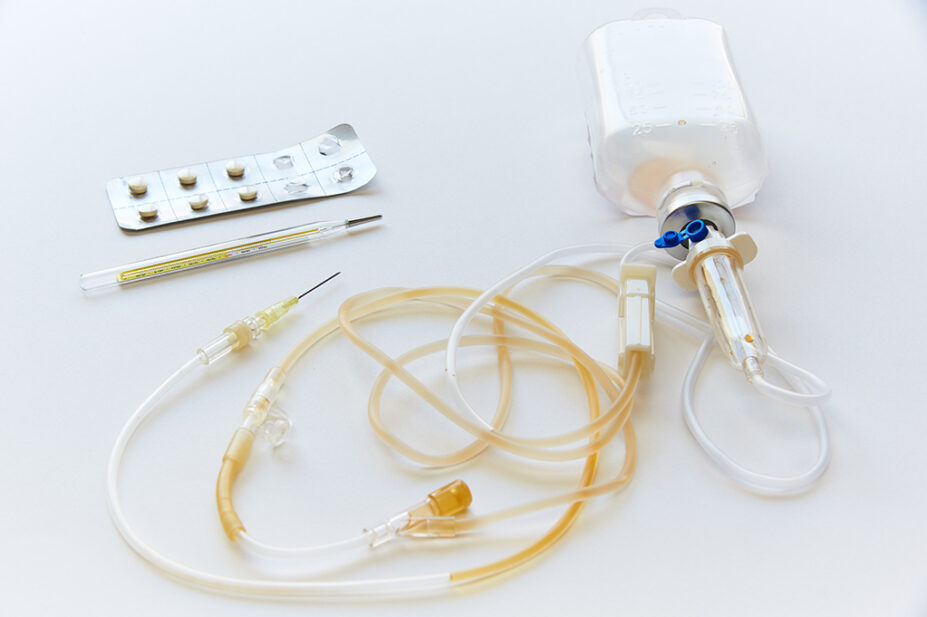
Shutterstock.com
After reading this article, you should be able to:
- Understand that intravenous-to-oral switch (IVOS) of antibiotics is an important objective for antimicrobial stewardship;
- List the benefits of timely IVOS and the national criteria;
- Identify interventions that may improve timely IVOS.
Introduction
IV antimicrobials are used when there is a need to achieve consistent, high concentrations of the antimicrobial in the bloodstream. This is important for the treatment of severe infections (e.g. sepsis or necrotising fasciitis) or for infections such as meningitis, where it can be difficult to achieve high drug concentrations owing to the blood-brain barrier[1].
IV antimicrobials are also used when there is concern about a patient’s ability to swallow an oral dosage form, reliability of absorption via the enteral route (e.g. decreased absorption owing to vomiting, diarrhoea or gut oedema) and drug-specific factors such as poor oral bioavailability of the oral form (e.g. aciclovir)[2].
Treatment durations with IV antimicrobials will vary according to the indication but could range from 0–24 hours for an uncomplicated bacteraemia to 14–21 days for herpes simplex encephalitis[3]. Data show that 22% of NHS hospital inpatients are being treated with IV antibiotics at any one time and 18 million treatment days of intravenous antibiotics are dispensed in English hospitals each year[4,5].
On average, based on data collated by RX-Info across 140 NHS acute hospital trusts, IV antibiotics account for 26% of total antibiotic treatment days, but this varies from 19% (10th centile) to 31% (90th centile), but this variation remains unexplained and potentially unwarranted[5].
In 2021, a study carried out by University Hospitals Birmingham revealed that 29% of 61,649 IV treatment days were from prescriptions that continued beyond the point that local switch criteria were met, with considerable variability evident between different medical and surgical teams[6]. If this was repeated at a national scale, significant reductions in IV antibiotic use could be possible. Interventions to improve timely IV-to-oral switching (IVOS) will reduce IV antibiotic use and improve antimicrobial stewardship across organisations.
This article will highlight the guidelines used to inform antimicrobial prescribing decisions, the benefits of IVOS, the recently compiled IVOS criteria and how switching should be managed.
Benefits of timely IV-to-oral switching
There are multiple benefits to timely IVOS, as summarised in the Box below. Switching promptly from IV to oral antibiotics can lead to improved patient outcomes. For example, evidence shows that intravascular catheterisation is associated with increased incidence of bloodstream infection[7,8]. If extrapolated nationally, this could potentially equate to 9,000 bloodstream infections each year in England associated with intravascular catheter use for IV antibiotics. A one-day reduction in IV antibiotic course length from an average of 3.5 days to 2.5 days could therefore result in 2,570 fewer bloodstream infections.
IV therapy is associated with increased probability of errors owing to the complexity of reconstitution, dilution, dose calculation and infusion rate calculation — results from a systematic review of preparation and administration of IV medication reported that the overall probability of making at least one error in IV therapy has been estimated to be 73%[9]. Furthermore, a semi-structured interview study in the UK revealed that 75% of patients preferred the oral route for antibiotics[10].
Importantly, with current workforce and bed occupancy pressures in the NHS, appropriate timely IVOS has been shown to reduce hospital length of stay, lower associated costs and save on nursing time[11]. A recently published systematic review investigating interventions to improve IVOS, identified 23 studies that reported hospital length-of-stay (LOS) data[12]. Eight reported a statistically significant reduction in LOS of 0.7-11.1 days, 5 studies reported a non-significant reduction in LOS and 10 reported no difference[12]. Economic outcomes of IVOS interventions were reported for 20 studies, all of which reported cost-savings per patient comprised of reduced drug-acquisition costs, administration costs and hospitalisation costs[12]. If IV antibiotic course length could be reduced from an average of 3.5 days to 2.5 days, replaced by one day of oral treatment in England, this would result in a saving in drug acquisition costs of £35m per annum (£250,000 per trust), while a one-dose reduction in IV antibiotic course length would save £10m per annum[5].
There are also sustainability benefits to timely IVOS. In comparison to oral dose forms, IV antibiotics and associated giving sets and infusion fluids require more energy to produce and transport and are often packaged in single-use plastic bags. Estimates from the Newcastle-upon-Tyne Hospitals NHS Foundation Trust suggest that, when given intravenously, the antimicrobial ciprofloxacin has a carbon footprint of 60 times higher than in tablet form[13]. The switch from IV to oral antibiotics can therefore contribute to a lower carbon footprint and a more sustainable NHS.
Box: Benefits of timely IV-to-oral switching
- Reduced length of hospital stay;
- Increased nursing capacity and time-to-care;
- Improved patient experience;
- Reduced risk of bloodstream infection;
- Fewer adverse events;
- Lower probability of errors and incidents;
- Reduced drug expenditure;
- Smaller carbon footprint;
- Reduced patient exposure to ‘Watch’ (highest priority critically important antimicrobials) and ‘Reserve’ antibiotics (antibiotics that should only be used as a last resort);
- Reduced requirement for therapeutic drug monitoring.
Antimicrobial prescribing guidelines
The current standard contract (2021/2022) service conditions for NHS providers in England and the Code of Practice for infection prevention and control (IPC) state that organisations must consider NICE guideline NG15 and the Antimicrobial Stewardship Toolkit for English Hospitals, often known as the ‘START SMART’ then ‘FOCUS’ antimicrobial stewardship toolkit[14–16]. This recommends reviewing the clinical diagnosis and the continuing need for antibiotics at 48–72 hours and documenting a clear plan of action — the ‘antimicrobial prescribing decision’.
The five ‘antimicrobial prescribing decision’ options are:
1. Stop antibiotics if there is no evidence of infection;
2. Switch antibiotics from intravenous to oral;
3. Change antibiotics — ideally to a narrower spectrum — or broader if required;
4. Continue and document next review date or stop date;
5. ‘Outpatient parenteral antibiotic therapy’ (OPAT)[16].
National standardised criteria to support IV-to-oral switching
Despite IVOS being highlighted in UK and US programmes, no standardised national or international IVOS criteria had been developed with acute hospitals globally following individualised local IVOS policies with the evidence-base informing their criteria largely unknown. In order to drive enhanced patient safety, better outcomes and improved quality of care[16–20], in 2022, UKHSA in collaboration with the AMR Programme team at NHS England initiated the development of the first set of national consensus criteria for prompt IVOS[21,22].
There are five main sections of the national criteria and a decision aid has been produced by the UKHSA. The decision aid is designed to identify the earliest point from which it is appropriate to ‘Prompt for switch’ (where a non-prescribing healthcare professional prompts the prescriber or infection specialist to consider an IVOS) or ‘Assess for switch’ (where the prescriber or infection specialist considers an IVOS).
The five main sections of the national criteria include:
- Timing of IV antimicrobial review: all patients on IV therapy should be reviewed promptly from first dose of IV antimicrobial with formal review completed within 48 hours and daily thereafter, unless clearly documented exemptions such as infective endocarditis or osteomyelitis;
- Clinical signs and symptoms of infection are improving;
- Infection markers. Temperature has been between 36 to 38°C for the past 24 hours, early warning score is decreasing, white cell count is trending towards the normal range or C-Reactive Protein (CRP) is decreasing. It is important to note that white cell count and CRP infection markers could also indicate inflammation or be affected by, for example, steroid treatment; a decision to ‘Prompt for switch’ or ‘Assess for switch’ may still be reached if they are the only markers from the criteria not met;
- Enteral route: these criteria focus on the patient’s ability to take oral medication, the gastrointestinal tract must be functioning with no evidence of malabsorption. The patient must be assessed as having a safe swallow or have enteral tube administration. A suitable oral switch option must be available, and oral bioavailability, any clinically significant drug interactions or patient allergies considered. There should be no significant concerns over patient adherence to oral treatment and the patient must not have vomited in the previous 24 hours;
- There are some infections that may require special consideration for longer IV treatment courses, including: deep-seated infections, infections requiring high tissue concentration, infections requiring prolonged intravenous antimicrobial therapy or critical infections with high risk of mortality. Though important to note that on specialist advice, an IVOS within 48 hours may still be indicated for some patients with these infections. Examples of infections for special consideration include, but are not limited to: bloodstream infection; empyema; endocarditis; meningitis; osteomyelitis; severe or necrotising soft tissue infection; septic arthritis; and undrained abscess.
How should the switch to oral be managed?
There are several considerations that need to be made when a patient is deemed to be suitable for an IV to oral switch, these can be categorised as patient, drug or infection factors. Patient factors include:
- Ability to swallow oral dose forms;
- Ability to absorb oral/enteral medication;
- Likelihood of adherence to treatment regimen;
- Willingness to switch to an oral/enteral dose form.
Drug and infection factors include:
- Availability of a suitable oral/enteral antimicrobial choice with activity against the definitive organism or likely pathogen;
- Availability and acceptability of a suitable formulation to meet patient’s needs (e.g. liquid versus solid dose form, or issues with taste or palatability);
- Adequate oral/enteral bioavailability to achieve exposure at the site of infection;
- Tolerability of oral/enteral agent at the dose required to treat the infection;
- Potential drug interactions with concomitant mediation if switching to an oral/enteral agent from a different class.
Once patients have been switched, some ongoing monitoring may be required to ensure that oral treatment is tolerated and that the patient continues to clinically improve; however, this is likely to be less than if the patient remained on IV antimicrobials. Therapeutic drug monitoring is not usually required.
Patients/carers should be advised on the importance of adherence to the treatment regimen, remaining course length and safety netting advice should be provided in case their condition deteriorates. Specific advice on red flag symptoms (e.g. fevers, chills, rigors, pale clammy skin, confusion, decreased responsiveness, decreased urine output) suggesting sepsis would prompt clinical review and should be provided when patients transition to the non-acute setting[23].
Barriers to and enablers of IV-to-oral switching
Despite the obvious benefits of IVOS, there is still significant variation in practice. A literature review found six studies containing information on barriers to switch and they identified the following key themes:
- Hierarchy of the medical team structure[24–29];
- Belief that IV antibiotics are superior to oral antibiotics and unwillingness to switch unless there is a direct oral equivalent[24–29];
- Operational pressures[25,27–29];
- Awareness of and access to IV to oral switch guidelines[28,29];
- Other: specific patient factors, skills (variability in clinical judgement suitability (lack of specificity) of guidance[26,29].
IV-to-oral switching as a quality improvement priority
Applying quality improvement (QI) approaches to IVOS has significant potential and there are many examples of successful QI projects taking place nationally. For World Antimicrobial Awareness Week 2022 in Wales, all Health Boards were encouraged to run IVOS Multi-disciplinary Team ward rounds during the week, with IVOS themed T-shirts worn by the team members. Antimicrobial pharmacy teams engaged with assistant medical directors or executive medical directors and invited them along. Within Cardiff and Vale University Health Board, daily IVOS ward rounds were carried out across University Hospital of Wales and University Hospital Llandough.
Data collected showed of the patients reviewed (n= 63):
- 35% were switched from IV to PO;
- 17% of prescriptions were stopped;
- 21% of patients had other interventions (e.g. escalating/deescalating treatment where appropriate; requesting further tests);
- 27% of patients were not suitable for PO switch.
Ward teams were very receptive, with the T-shirts acting as visual prompts for staff to approach the IVOS team members to ask questions about the campaign and open a dialogue. This work became embedded in twice-a-week IVOS ward rounds on medical wards at University Hospital of Wales, with input from microbiology, antimicrobial pharmacists and ward teams. Similarly, in the Prince Philip Hospital in Llanelli, the IVOS ward round has been adopted as a permanent weekly MDT ward round with microbiology and pharmacy.
A further example in England is a point prevalence survey that was designed and tested to capture baseline clinical practice from a sample of NHS acute hospital trusts across all regions of the NHS in England. In total, 399 patients were audited in 34 acute hospital trusts in England (range 10–30 patients, average 11.7 patients per trust) during August and September 2022. A total of 161 patients (43%) were suitable for IVOS at the point of audit, while 29 trusts were able to provide data on unnecessary days of IV treatment. A total of 259 unnecessary days of IV treatment were estimated, which was an average of 1.6 days per patient eligible for switch (range 0–18 days).
Resources to support IVOS implementation have also been developed across the UK. The East of England regional team has developed a section on the FutureNHS Collaboration Platform, which includes a suite of independent resources on IVOS, including a clinical decision support tool for use with the MicroGuide prescribing guidelines app, posters, guidelines and slide sets. Please note that these resources have not been peer reviewed.
In Scotland, the hospital antibiotic review programme (HARP), led by the Scottish Antimicrobial Prescribing Group and NHS Education Scotland, contains practical tools and ideas for quality improvement underpinned by educational resources. It includes a range of examples of interventions that can be used when considering how to promote IVOS for patients in a ward setting. Hints and tips about how to start local quality improvement projects to promote IVOS and detailed examples of what has been tested and found to be effective are available on the platform.
In addition to these suggestions, the HARP resource includes links to other tools that can be tested to encourage IVOS, including stickers, to add to the patient record to prompt IVOS review and the ReCord tool — a guide to antibiotic review for prescribers and audit tools that can be used locally.
Summary
Timely IVOS has many benefits to patients, staff and the healthcare system as a whole. Data show there is variability in practice highlighting the opportunity for improvement. There is now a set of national standardised switch criteria derived from a robust Delphi process to guide switching. There are many resources available from across the UK that can be used to support timely IVOS and examples of good practice that show the benefits of implementing timely IVOS in practice.
Acknowledgements
We would like to acknowledge all those that took part in the East of England IVOS stakeholder event, those colleagues that contributed to the Delphi process and those that undertook the baseline survey in England to inform the CQUIN indicator.
- 1Nau R, Seele J, Djukic M, et al. Pharmacokinetics and pharmacodynamics of antibiotics in central nervous system infections. Current Opinion in Infectious Diseases. 2018;31:57–68. doi:10.1097/qco.0000000000000418
- 2Aciclovir. Summary of Product Characteristics (SmPC). Electronic Medicines Compendium. https://www.medicines.org.uk/emc/product/4334 (accessed Apr 2023).
- 3Al-Hasan MN, Rac H. Transition from intravenous to oral antimicrobial therapy in patients with uncomplicated and complicated bloodstream infections. Clinical Microbiology and Infection. 2020;26:299–306. doi:10.1016/j.cmi.2019.05.012
- 4English Surveillance Programme for Antimicrobial Utilisation and Resistance (ESPAUR) Report 2017 . Public Health England 2017. https://webarchive.nationalarchives.gov.uk/ukgwa/20181130125613/https:/www.gov.uk/government/publications/english-surveillance-programme-antimicrobial-utilisation-and-resistance-espaur-report (accessed Apr 2023).
- 5IV antibiotic treatment days as a proportion of total antibiotic treatment days for 126 NHS Hospital Trusts in England . Rx-info (Unpublished data). https://www.rx-info.co.uk/products/define (accessed Apr 2023).
- 6Dutey-Magni PF, Gill MJ, McNulty D, et al. Feasibility study of hospital antimicrobial stewardship analytics using electronic health records. JAC-Antimicrobial Resistance. 2021;3. doi:10.1093/jacamr/dlab018
- 7Rojo D, Pinedo A, Clavijo E, et al. Analysis of risk factors associated with nosocomial bacteraemias. Journal of Hospital Infection. 1999;42:135–41. doi:10.1053/jhin.1998.0543
- 8Maki DG, Kluger DM, Crnich CJ. The Risk of Bloodstream Infection in Adults With Different Intravascular Devices: A Systematic Review of 200 Published Prospective Studies. Mayo Clinic Proceedings. 2006;81:1159–71. doi:10.4065/81.9.1159
- 9McDowell SE, Mt-Isa S, Ashby D, et al. Where errors occur in the preparation and administration of intravenous medicines: a systematic review and Bayesian analysis. Quality and Safety in Health Care. 2010;19:341–5. doi:10.1136/qshc.2008.029785
- 10Bamford KB, Desai M, Aruede MJ, et al. Patients’ views and experience of intravenous and oral antimicrobial therapy: room for change. Injury. 2011;42:S24–7. doi:10.1016/s0020-1383(11)70129-2
- 11Mertz D, Koller M, Haller P, et al. Outcomes of early switching from intravenous to oral antibiotics on medical wards. Journal of Antimicrobial Chemotherapy. 2009;64:188–99. doi:10.1093/jac/dkp131
- 12Garwan YM, Alsalloum MA, Thabit AK, et al. Effectiveness of antimicrobial stewardship interventions on early switch from intravenous-to-oral antimicrobials in hospitalized adults: A systematic review. American Journal of Infection Control. 2023;51:89–98. doi:10.1016/j.ajic.2022.05.017
- 13Walpole S, Eii M, Aldridge C. Medicines are responsible for 22% of the NHS’s Carbon Footprint: How do the footprints of int ravenous and oral antibiotics compare? Federation of Infection Societies Conference abstract. 2021.https://az659834.vo.msecnd.net/eventsairwesteuprod/production-fitwise-public/c73ca41748814cf78bc73fab15f5c5d2 (accessed Apr 2023).
- 14Standard contract (2021-22) service conditions for NHS providers in England. NHS England. 2021.https://www.england.nhs.uk/nhs-standard-contract/previous-nhs-standard-contracts/21-22/ (accessed Apr 2023).
- 15Health and Social Care Act 2008: code of practice on the prevention and control of infections . Department of Health and Social Care . 2015.https://www.gov.uk/government/publications/the-health-and-social-care-act-2008-code-of-practice-on-the-prevention-and-control-of-infections-and-related-guidance (accessed Apr 2023).
- 16Ashiru-Oredope D, Budd EL, Bhattacharya A, et al. Implementation of antimicrobial stewardship interventions recommended by national toolkits in primary and secondary healthcare sectors in England: TARGET and Start Smart Then Focus. J. Antimicrob. Chemother. 2016;71:1408–14. doi:10.1093/jac/dkv492
- 17Goff DA, Bauer KA, Reed EE, et al. Is the ‘Low-Hanging Fruit’ Worth Picking for Antimicrobial Stewardship Programs? Clinical Infectious Diseases. 2012;55:587–92. doi:10.1093/cid/cis494
- 18National Early Warning Score (NEWS) 2: Standardising the assessment of acute-illness severity in the NHS. Royal College of Physicians. 2017.https://www.rcplondon.ac.uk/projects/outputs/national-early-warning-score-news-2 (accessed Apr 2023).
- 19Clinical guidelines and standardization of practice to improve outcomes. Committee opinion no. 629. 125(4): p. 1027-1029. American College of Obstetricians and Gynaecologists. 2015.https://www.acog.org/clinical/clinical-guidance/committee-opinion/articles/2019/10/clinical-guidelines-and-standardization-of-practice-to-improve-outcomes (accessed Apr 2023).
- 20Stone J. Defining standardization and personalized care, Medical GPS, Editor. Medical GPS. 2022.https://blog.medicalgps.com/defining-standardization-and-personalized-care/ (accessed Apr 2023).
- 21Harvey EJ, McLeod M, De Brún C, et al. Criteria to Achieve Safe Antimicrobial Intravenous-to-Oral Switch in Hospitalised Adult Populations: A Systematic Rapid Review. 2022. doi:10.1101/2022.09.01.22279505
- 22Harvey EJ, Hand K, Weston D, et al. Development of National Antimicrobial Intravenous-to-Oral Switch Criteria and Decision Aid. JCM. 2023;12:2086. doi:10.3390/jcm12062086
- 23Sepsis: recognition, diagnosis and early management, NICE guideline [NG51]. National Institute for Health and Care Excellence. 2016.https://www.nice.org.uk/guidance/NG51 (accessed Apr 2023).
- 24Broom J, Broom A, Adams K, et al. What prevents the intravenous to oral antibiotic switch? A qualitative study of hospital doctors’ accounts of what influences their clinical practice. J. Antimicrob. Chemother. 2016;71:2295–9. doi:10.1093/jac/dkw129
- 25Engel MF, Postma DF, Hulscher MEJL, et al. Barriers to an early switch from intravenous to oral antibiotic therapy in hospitalised patients with CAP. European Respiratory Journal. 2012;41:123–30. doi:10.1183/09031936.00029412
- 26CHUA HM, ISLAHUDIN F, TAHIR NAM, et al. Factors Influencing Intravenous-to-Oral Antibiotic Switch among Private Healthcare Providers in Malaysia. pharmaceutical-sciences. 2020;82. doi:10.36468/pharmaceutical-sciences.696
- 27Nathwani D, Lawson W, Dryden M, et al. Implementing criteria-based early switch/early discharge programmes: a European perspective. Clinical Microbiology and Infection. 2015;21:S47–55. doi:10.1016/j.cmi.2015.03.023
- 28Hogan-Murphy D, Waqas S, Tuite H, et al. What Stops Doctors Switching from Intravenous to Oral Antibiotics? Ir Med J 2019;112:987.https://www.ncbi.nlm.nih.gov/pubmed/31650816
- 29Warburton J, Hodson K, James D. Antibiotic intravenous-to-oral switch guidelines: barriers to adherence and possible solutions. International Journal of Pharmacy Practice. 2014;22:345–53. doi:10.1111/ijpp.12086


